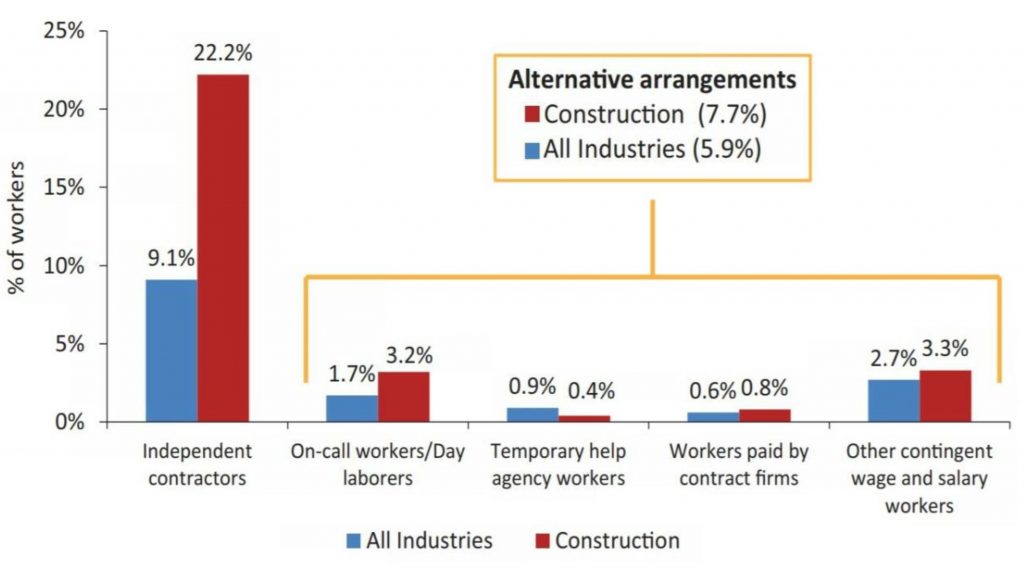Nonstandard Work in Construction Impacts Safety
BY AsphaltPro Staff

Almost one third of all construction workers are considered to be employed in nonstandard work arrangements, according to a recent report by the Center for Construction Research and Training (CPWR), Silver Spring, Maryland. The report found that the construction industry has the second-highest rate of nonstandard work arrangements of all industries, second only to the agriculture, forestry and fishing industry (44 percent).
A number of studies have shown that nonstandard employees are at a greater risk for occupational injuries, illnesses and other adverse health outcomes as a result of their work arrangement. That’s why it’s important to understand who among your employees is considered nonstandard and to think about how you might improve the safety of these workers in your organization.
Define Nonstandard Work Arrangements
“A lot of different words have been used over the last several years to talk about nonstandard work arrangements, from contingent workers to day laborers, the gig economy to contract workers,” said Rebecca Jackson, assistant director of CPWR’s data center. “The unifying idea of all of these terms is that there is no expectation of permanent employment. If you do a good job, that doesn’t mean you’ll continue to have your job. Instead, you expect your work to be temporary.”
This can include on-call workers and day laborers, workers provided by a contract firm, temporary help agency workers, and independent contractors/self-employed individuals.
“My own experience suggests that 30 percent of construction workers belonging to nonstandard work arrangements is probably an underestimate,” Jackson said. “The reason we’re interested in this from a health and safety perspective is our jobs are how we access legal benefits like workers compensation, unemployment benefits, health and safety enforcement, and social benefits like vacation, sick leave and health care.”
CPWR’s most recent quarterly data report does not explore health outcomes and injury rates among people engaged in nonstandard work arrangements because such data wasn’t collected in the 2017 Contingent Worker Supplement to the Current Population Survey (CPS), a household survey conducted by the U.S. Bureau of Labor Statistics (BLS), the data from which CPWR used to prepare its report.
“We specifically need more information on how this complex web of work arrangements affects occupation safety and health, as well as physical, mental and emotional health,” Jackson said.
Data Shows Disparities

Nonstandard work arrangements as a percent of total employment. Source: CPWR’s Quarterly Data Report, “Nonstandard Work Arrangements in the Construction Industry”
Nonstandard work arrangements are roughly twice as common in the construction industry as they are across all industries. About 30 percent of construction workers were employed in nonstandard work arrangements, 22 percent as independent contractors (9 percent for all industries) and 8 percent in alternative arrangements, including temporary workers, day laborers, on-call workers, and workers provided by contract firms (6 percent for all industries).
Half of the construction workers in alternative arrangements would have preferred a different work arrangement; one third said alternative arrangements were the only type of employment they could find. On the other hand, only 9 percent of independent contractors preferred a different arrangement; 35 percent say they choose this type of employment because they enjoy being their own boss.
Workers in alternative arrangements were more likely to be Hispanic, foreign born, and to have less than a high school diploma. They were also less likely to have health insurance from any source. Only half of workers in alternative arrangements had health insurance from any source, compared to 68 percent for standard employees. Only one-quarter of workers in alternative arrangements had employer-sponsored health insurance, compared to 42 percent for standard employees.
As Jackson said, more research on the correlation between nonstandard work arrangements and occupational health and safety needs to be done. In the meantime, consider your own employment agreements and how they might impact the safety of your workers—standard and nonstandard.
Do you treat workers with whom you have nonstandard work arrangements differently from your standard employees? Do they receive adequate safety training? Are they expected to wear personal protective equipment? Do any nonstandard workers sit on your safety committees? And how might that impact their overall safety?
Every crew member—standard or nonstandard—should make it home safely at the end of the shift.
